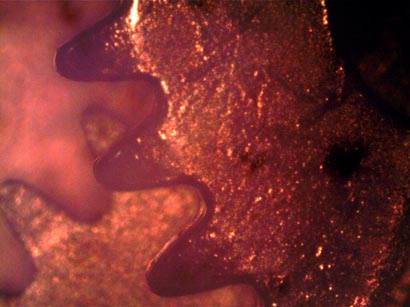 and 3x (26.8 MB .wmv).
and 3x (26.8 MB .wmv).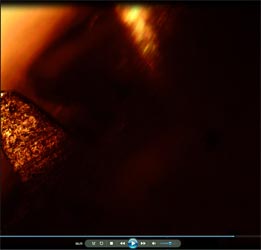
Reflected-light (episcopic, or metallurical) microscopy is for looking at the surfaces of objects, rather than through them, as with a biological microscope. Many of the same techniques are available, although the implementation is different. Both upright (like an Optiphot with an epi-illuminator) and inverted (like an Epiphot) configurations are useful for different applications. I have made a 10 minute introductory video using an Epiphot giving examples to illustrate various techniques. (90.1 MB .MP4).
Here are a few videos of polarization changes viewing a bare CCD chip in reflected light, using 10x Differential Inteference Contrast taken through the microscope. Enjoy!
Rotating input polarizer in a reflected DIC setup (9.8 MB .gif)This is also a rotating polarizer with 10x episcopic-DIC, of the surface of black and white photographic paper. Note that sometimes features appear as "hills", and sometimes "valleys". (9.2 MB .GIF) This is one of the comparison specimens.

This one is simply a brightfield diascopic (on the inverted Diaphot) video of Rhodamine B crystals going into solution in 99% isopropanol. This is with a 20x objective. (31.4 MB .wmv)
Rhodamine B crystals going into solution in isopropanol.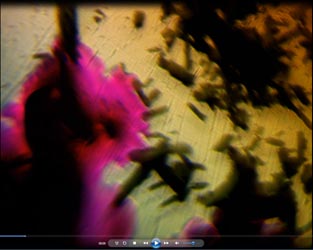
Control of polarization can result in some truly spectacular images.
I've been working with a form of darkfield Rheinberg illumination, with startling results.
Here is some fresh moss (10.3 MB .gif) that, of course, is very 3-D. A focus stack was not easily done, so here is an animated GIF going through focus. It is 22 frames with a 10x BD Plan objective in reflected darkfield Rheinberg mode.
By using his excellent software, Zerene Stacker, Rik Littlefield was able to put together a 3D reconstruction of the moss from the animated GIF above. Thanks, Rik! I love it!
Similarly, here is 93 frames of 20x Disco Lights Illumination through focus of mold on a petri dish. Mold animiation (35.9 MB .gif).
I got some video of a tiny spider (~ 2 mm) (9.7 MB .wmv).
reacting to the UV light
And another, longer one (134 MB). At one point, I swear he's talking to me... likely telling me to QUIT IT with the bright light!
Spider at 10x fluorescence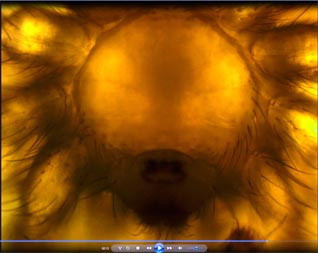
Here is one I set to music (Michael Hedges) of several applications of 99% isopropanol on a bare slide, using a 5x M Plan objective with reflected light DIC (87.3 MB .wmv).

I found some lacewing eggs and about 54 hours later, they hatched! I'll put up more, but for now, here are a couple of animated gifs.
1 (4.8 MB .gif) and 3 (5.4 MB .GIF). Here is a focus stacked rocking animation 2 (3.7 MB .GIF).



I also got some video of a gear box in action with the Model S-Epi at
2x (36.6 MB .wmv) and 3x (26.8 MB .wmv).
and 3x (26.8 MB .wmv).
An interesting effect I had noted while playing with liquid polyimide (Nissan Chemical Sunever 2170), was that if it touches water, it instantly polymerizes... I thought it would be interesting to watch it happen microscopically - turns out I was right! video (23.8 MB .wmv). This was taken with a drop of water introduced from the side of the existing drop of polyimide. Dropping the water on top of the polyimide drop had a visually different effect - it "instantly" coated the whole top of the droplet, going from clear to brown without being able to see it happen! (video 10.5 MB .wmv)


Evaporating water can be fatal to protists! The reduced volume of water between the slide and cover glass draws the cover glass closer to the slide by surface tension, making a very powerful press. This sequence shows a poor fellow that got stuck, expanded, and exploded as the water evaporates.
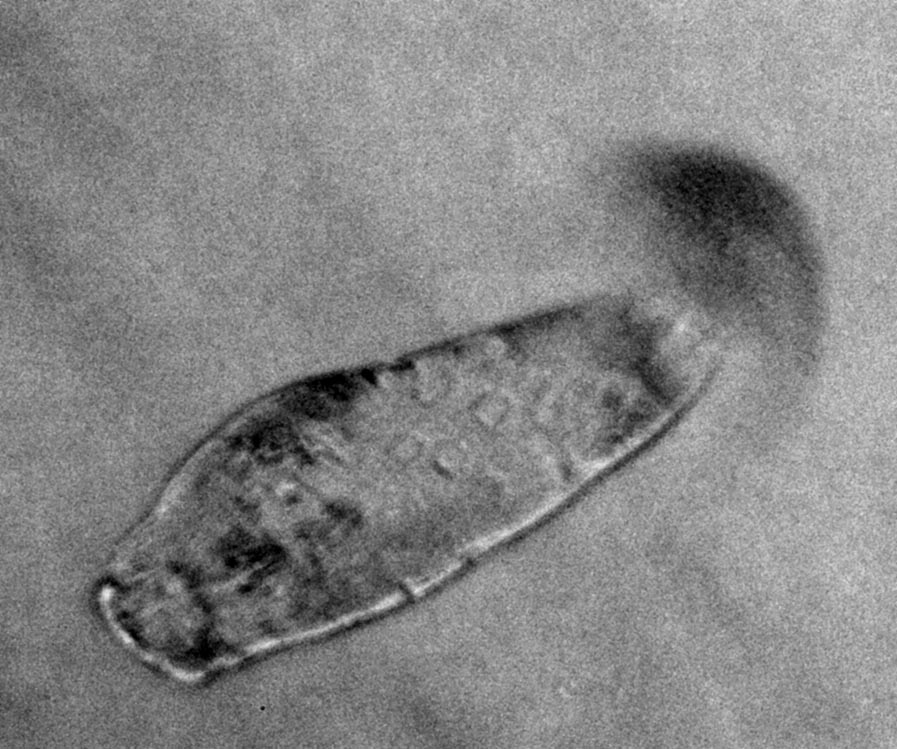 (13.5 MB .GIF)
(13.5 MB .GIF)
In the same session, with a 20x Hoffman Modulation Contrast objective, the following video was recorded. These are with the Nikon Diaphot TMD inverted biological microscope with a Nikon D3300 APS-C digital camera attached.
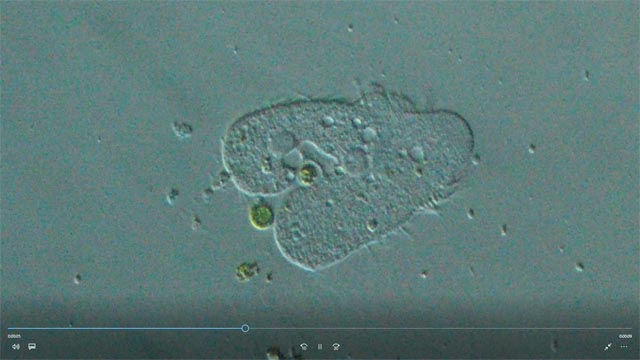 (39.2 MB .MOV)
(39.2 MB .MOV)
Diamond bit Dremel tools really can tear up glass! Here is a Zerene Stacker 3D output, showing the topology clearly.
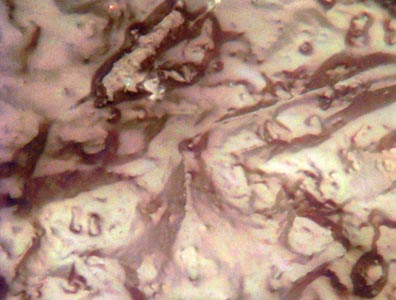 (14.6 MB .GIF)
(14.6 MB .GIF)
In the construction of large honeycomb mirror blanks at the Mirror Lab, a "green ceramic" is used as the mold material. It is called ceramic refractory fibers, which are like asbestos needles embedded in a chalk-like material. They look very cool under Disco Lights Illumination with a 3D twist, but don't breathe them!
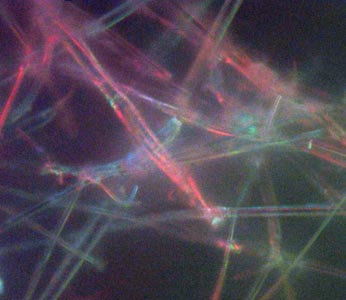 (3.9 MB .GIF)
(3.9 MB .GIF)
Here is a fun one! Disco Light Illumination (5x BD) of small grains of magnetic rock from the Rillito River, set to music. Some of those conglomerations of small rocks must have been 3 mm long, so difficult to focus on when vertical.
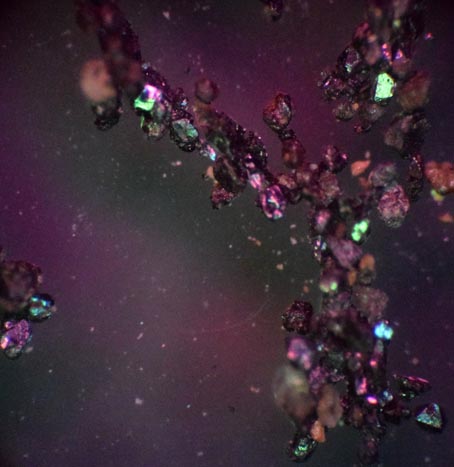 (122 MB .wmv)
(122 MB .wmv)
Amoeba Rhizamoeba flabellata (unconfirmed) with 40x Hoffman Modulation Contrast. (12.1 MB .GIF).
Chiral nematic liquid crystal cooling from the isotropic phase, 40x crossed polarizers with transmitted light. (29.9 MB .avi).
You may also visit my PBase site at http://www.pbase.com/the_microscope_tuell